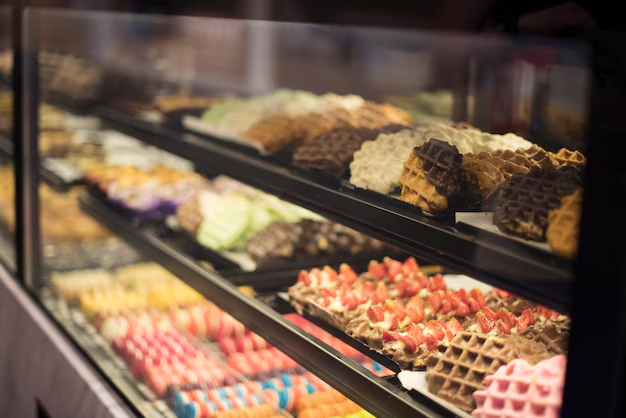Can Cakes Turn Blue in the Refrigerator? Unraveling the Mystery and More!
Does it sound bizarre to talk about cakes mysteriously changing color in the fridge? You're not alone if you've wondered whether a cake transforms into a startling blue hue when left to chill. There's more here than meets the eye, and a surprising array of factors that might trigger such a transformation. So, let's dive into this peculiar topic and explore why cakes might turn blue in the refrigerator, along with some fascinating side discussions about cake preservation, coloring quirks, and storage tips.
🧁 The Curious Case of the Blue Cake: What's Really Happening?
The Role of Ingredients in Color Change
One of the most common reasons a cake might turn blue is due to the ingredients used. Often, blueberries, purple carrots, or other naturally pigmented ingredients, when subjected to varying pH levels, can shift color. When you place a cake in the refrigerator, the pH might change slightly due to cold temperatures or interaction with other foods, leading to a fascinating hue change.
- 🌈 Natural Pigments: Fruits like blueberries and certain vegetables contain anthocyanins, which can cause a color shift. In acidic environments, these colors appear red, while in neutral they show purple, and in alkaline they become blue-green.
- 💡 Takeaway: If using these ingredients, don't be alarmed by color changes; it's a natural reaction.
Chemical Reactions: Baking and Storage
There are also chemical reactions that could be involved in altering cake colors. Baking soda and baking powder, common leaveners in cake recipes, are alkaline and may interact with other ingredients, affecting color during refrigeration.
- 🧪 Acid-Base Reactions: Cakes or icings with acidic properties might react and produce color changes when cold.
- Practical Tip: To minimize unexpected changes, restrain from overusing baking soda unless balanced with enough acidic ingredients (like buttermilk or lemon juice).
🥶 Refrigerator Science: Why Cold Storage Matters
Temperature and Humidity Effects
Keeping your cake in the fridge ensures it stays fresher for longer, but it's crucial to be mindful of temperature and humidity. These factors can contribute to diverse outcomes, including color alterations.
- 🌡️ Cooling Comfortably: Make sure cakes are cooled completely before refrigerating. Warm cakes can trap moisture and lead to condensation, exacerbating chemical reactions.
- Humidity Handling: High humidity in the fridge can lead to icing issues or patchy colors. Use airtight containers or covers to manage moisture levels.
Interaction with Odors and Flavors
Refrigerators can harbor a mix of aromas that influence the flavor and occasionally the coloration of baked goods.
- 🚫 Odor Solutions: Store cakes away from strong-smelling foods like onions or garlic to prevent flavor interference.
- Taste Preservation: Use wrapping or containers to insulate cakes, keeping the taste intact and colors unaffected by neighboring scents.
🎨 From Icing to Intrigue: How Colors Morph
Food Colorings and Reactions
Another layer to the color-change saga lies in food coloring. Certain dyes react with other ingredients and the fridge's atmospheric conditions, occasionally leading to unexpected results.
- 🍰 Dye Dynamics: Colors like red and green are notorious for bleeding or changing under the influence of acidic reactions common in refrigeration.
- Guidance: Consider natural dyes for more stable coloring and test small batches to see how these behave in your specific conditions.
Hidden Ingredients: Unseen Interactions
Sometimes, minor ingredients not considered significant can account for color shifts, such as stabilizers, emulsifiers, or even the mineral content in water.
- Mystery Additives: The baking world is rife with subtle ingredient mysteries.
- Problem Solving: If you frequently face this issue, examine ingredient labels you use for unexpected interactions.
🔄 Evolving Perspectives: Cake Storage and Maintenance
Alternative Storage Methods
Not all cakes demand refrigerator storage; some are better suited to other environments depending on their composition.
- 🍯 Preserve or Not: Cakes without cream fillings or those that thrive in room temperature (like pound cakes) might be better suited outside the fridge.
- Strategic Storage: Balance shelf life desires with environmental conditions to optimize cake health and prevent surprise color changes.
Troubleshooting and Testing
If you're still curious or concerned about potential color changes in your cakes, conduct a straightforward experiment.
- 🔍 DIY Investigation: Take a sample of your cake, store it in the refrigerator, and mark your observations. Note which elements are most prone to color changes and adjust recipes accordingly.
- Feedback Loop: Apply learnings to adapt techniques, aiming for stability without compromising taste or quality.
📋 Quick Tips for Perfect Cake Care
To ensure your cakes remain both tasty and visually appealing, consider the following:
- Seal with Love: Store in airtight containers to limit interaction with moisture and other foods.
- Cool Wisely: Always let cakes come to room temperature before refrigeration.
- Consider the Climate: Understand that different icings and cakes require distinct storage environments.
- Experiment Safely: Use small test batches when you're uncertain about ingredient interactions.
- 💡 Infographic Snapshot
| Situation | What to Do 📌 |
|---|---|
| Blueberry Cake Turns Blue | Don't panic; natural color shift. |
| Icing Changes Hue | Examine pH and food colorings. |
| Minor Odor Transfer | Wrap cake well. |
| Uneven Color | Check for proper cooling. |
While the notion of a blue-hued cake might seem purely anecdotal or even slightly far-fetched, delving into the why and how offers a glimpse into the playful unpredictability of culinary science. With these pointers in hand, you can feel confident navigating the colorful world of cake storage with fewer surprises, ensuring that both taste and appearance align with your expectations. Happy baking and storing! 🍰
